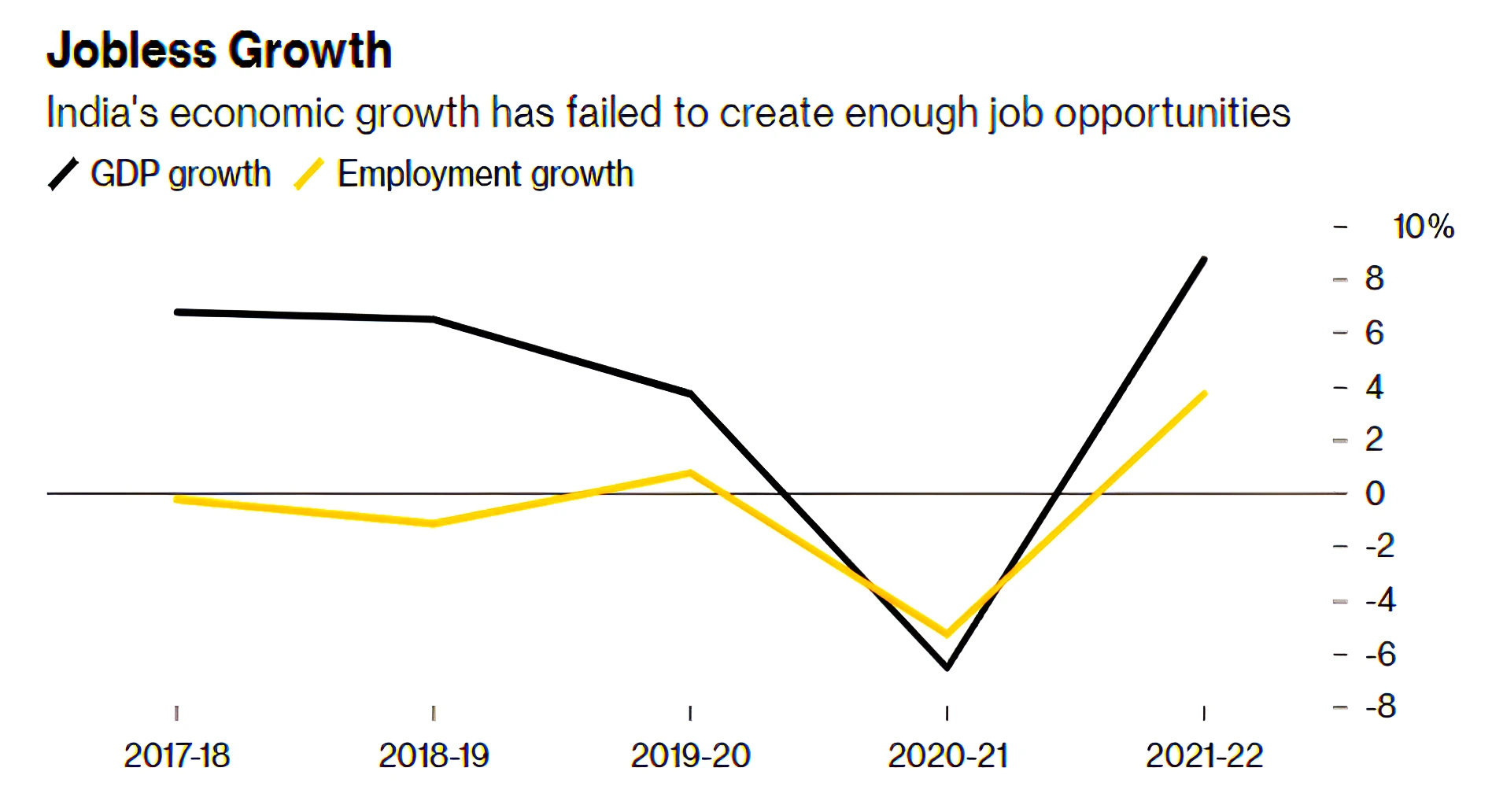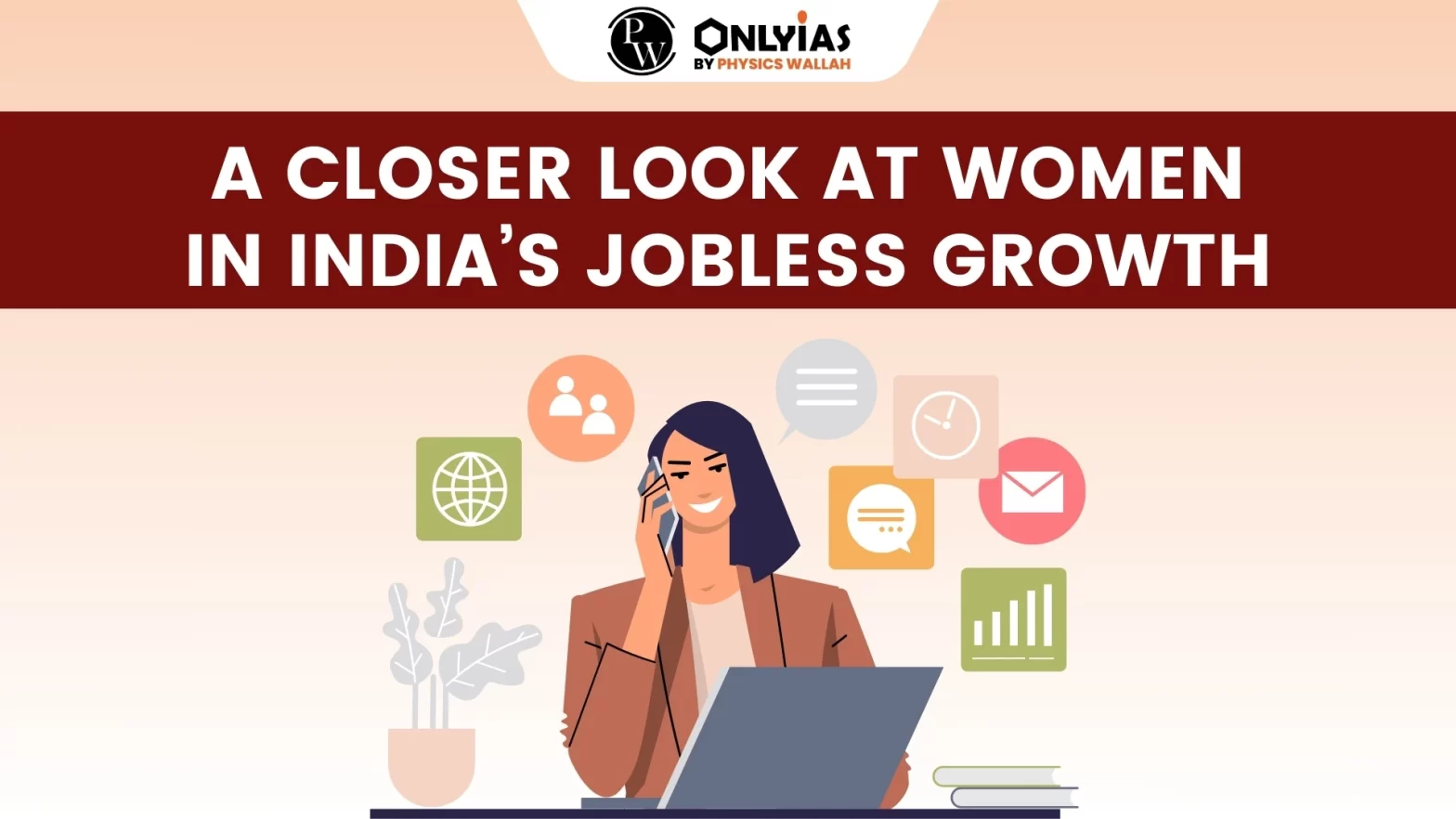Context: This article is based on the news “Women are losing out to men in India’s jobless growth” which was published in the Live Mint. According to quarterly Periodic Labour Force Survey (PLFS) data, the share of women in regular salaried jobs in urban India dropped from 54% in the first quarter to 52.8% in the second quarter in 2023.
| Relevancy for Prelims: Jobless Growth, Periodic Labour Force Survey, International Labour Organisation, Mission Shakti (Sambal and Samarthya components), and National Rural Livelihood Mission (DAY-NRLM).
Relevancy for Mains: Women in India’s Jobless Growth, Factors responsible for low share of women in jobs, and What steps has the government has taken to increase the female labour force participation rate? |
Women in India’s Jobless Growth
- PLFS Data: The survey showed that the share of women who are self-employed and doing casual work increased to 40.3% in Q2 from 39.2% in Q1, while that of casual workers increased marginally to 6.9% in Q2 from 6.8% in Q1.
- International Labour Organisation (ILO) Data: It states that the employability gender gap in India is 50.9%, with only 19.2% of women in the labour force compared to 70.1% of men.
- Less than 20% of India’s women work at paid jobs and female workforce participation has been declining in the country.
- Centre for Monitoring Indian Economy (CMIE) Data: Unemployment rates in rural areas experienced a sharp increase to 9.2 percent in February 2022, whereas urban areas witnessed a reversal in the previous trend, reaching 7.5 percent.
- Despite this, one in four urban women, aged 15-29, are unable to secure employment.
- Salaried Jobs for Women: The increase in education has not led to an increase in salaried jobs for women, which shows the economy is not creating enough salaried jobs, and that employers retain their preference for men.
Know more about the Periodic Labour Force Survey (PLFS) Annual Report 2022, here.
Salaried Work Over Casual Work
- Since salaried workers receive regular wages, hence it is preferred over casual work and self-employment, which also includes working as unpaid household help in agricultural fields or owning a tiny business.
- Categories of Self-Employed People
- Own-Account Workers: Self-employed people operate their enterprises on their own or with one or more partners and who, by and large, do not hire any labour.
- Employers: Self-employed people who work on their own or with one or more partners and who, by and large, hire labour.
- Helpers in a Household Enterprise: Self-employed people engaged in household enterprises, working full-time or part-time, who do not receive a regular salary.
|
Must Read: Women Participation in Workforce and India’s Economic Growth
What is Jobless Growth?
- Concept of Jobless Growth: It refers to a situation where economic growth does not lead to job creation.
- This phenomenon can occur when a country emerges from a recession and despite an expanding economy, unemployment remains the same or worsens.
- This tends to happen when a relatively large number of people have lost their jobs, and the ensuing recovery is insufficient to absorb the unemployed, under-employed, and those first entering the workforce.

- Jobs and Growth: Economies experience cyclical as well as structural changes as they recover from a recession.
- In a cyclical economy, employment growth and decline follows the expansion and contraction of the economy.
Factors Responsible for Jobless Growth in India
- Increasing investments in capital equipment and automation.
- Growing reliance on high skilled workers and professionals.
- Sectoral inefficiencies.
- Labour market rigidity.
|
-
- A structural change is a fundamental shifts in an economy and exacerbated by external factors such as technology, competition, and government policy
- Jobless Growth in India: Even though India is one of the world’s fastest-growing economies, it has been characterized by jobless growth and informalisation of job opportunities in the organized sector.
- India has undergone a major structural transformation from farm to services sector.
- Much of the country’s economic growth is driven by finance, real estate, and IT sectors, which are not major job creators, unlike manufacturing sector.
- Less than half of college graduates in India have the skills that companies need, exacerbating jobless growth.
- The economy has added nearly 57 million jobs in five years to June 2022, leading to India’s workforce growing to 493 million, but 35 million people remained unemployed.
What factors contribute to the low representation of women in paid jobs?
- Distress Driven Self-Employment: Rise in women’s participation in India’s labour force was led by self-employment, likely driven by distress more than economic growth.
- For instance, According to a report titled “State of Working 2023” released by Azim Premji University’s, self-employment among women was up 14 percentage points to nearly 65% between the quarter ended June 2018 and the quarter ended December 2022.
- Pandemic Induced Shecession: The pandemic disproportionately affected women, leading to the “shecession,” as sectors like retail and hospitality, where women are more prevalent, were significantly impacted.
- The World Economic Forum (WEF) has highlighted that progress towards gender parity has been halted and even reversed due to the Covid-19 pandemic.
- Societal Norms and Gender Roles: Conservative societal norms in India prioritise women’s roles within the family, often leading them to leave their jobs, especially after marriage or after having children.
- India has a number of factors that hold women back from paid work and this downward trend applies to women across different social classes, religions, and age groups.
- Gender Pay Gap: Disparities in earnings were observed across casual work, regular jobs, and urban self-employment, further reinforcing the gender wage gap.
- The Oxfam India Discrimination Report 2022 highlighted the gender pay gap in India, with women facing bias in recruitment and pay across the country.
- The gender pay gap is also evident in technology roles, with women earning less than men, even more so in senior management positions.
- Bias Against Hiring Women: When employing women, firms face a multifaceted set of challenges ranging from unclear female labor regulations, to the high cost of accommodating workplaces, to low retention of workers.
- For instance, ‘pregnancy discrimination’ is to treat a woman unfavourably on the grounds of her pregnancy or because she wants to take or has taken maternity leave.
- Safety concerns: Migration and safety concerns further limit women’s access to employment. Inadequate urban infrastructure, along with safety issues in public spaces, can discourage women from seeking and retaining jobs, particularly in urban areas.
Also Read: Gender Parity At Workplace
What government initiatives exist in India to enhance the participation of women in the workforce?
- Ensuring Compatible Work Environment: To encourage employment of women, a number of enabling provisions have been incorporated in the recently enacted Labour Codes viz. the Code on Wages, 2019, the Industrial Relations Code, 2020, the Occupational Safety, Health and Working Conditions Code, 2020 and the Code on Social Security, 2020 for creating compatible work environment for women workers.
- Increase Participation of Women in Science, Technology, Engineering and Mathematics (STEM): Vigyan Jyoti was launched to balance low representation of girls in different streams of Science and Technology from 9th to 12th standards.
- Mission Shakti: It has two components, Sambal and Samarthya. Under “Sambal”, components such as Beti Bachao Beti Padao, One Stop Centre, Women Help Line and Nari Adalat are in operation. Under “Samarthya”, the components are Pradhan Mantri Matru Vandana Yojana, Shakti Sadan, Hub for Empowerment of Women, Sakhi Niwas i.e. Working Women Hostel, Palna, Anganwadi cum Creches.
- Deen Dayal Antyodaya Yojana National Rural Livelihood Mission (DAY-NRLM): Under DAY-NRLM, nearly 90 lakh women Self Help Groups (SHGs) having nearly 10 crores female members are transforming the rural landscape with regard to women’s economic empowerment.
- Improving Political Participation: Nari Shakti Vandan Adhiniyam, 2023 Act, 2023 was introduced for reservation of one-third of seats for women in the Lok Sabha and in the State Legislative Assemblies including Legislative Assembly of NCT of Delhi.
Way Forward
- The ILO suggests the following strategies to bridge the workforce gender gap:
- Ensuring equal pay for work of equal value through legal protection, wage transparency, and gender-neutral job evaluation.
- Addressing occupational segregation by challenging preconceived notions about the value of certain types of work.
- Eliminating gender discrimination and harassment through legislation, effective remedies, and awareness campaigns.
- Promoting work-family balance through adequate maternity protection, paid paternity and parental leave, and social protection measures.
- Creating quality care jobs and improving regulation and protection for care professionals.
- Implementing gender-responsive policies to safeguard women’s employment during economic downturns.
- Need for Better Government Measures: Despite existing legislation such as the Equal Remuneration Act and the Minimum Wages Act, women’s labour is undervalued in rural areas, the unorganised sector, and the private sector. This highlights the need for improved policy formulation with robust implementation.
- These is a need initiatives such as financial support for women entrepreneurs, improved education and training access, gender equality promotion, safety and security measures, increased job opportunities, better work policies, etc.
- Supporting Women Entrepreneurs: By establishing and running their own businesses, women entrepreneurs can not only generate employment opportunities for other women but also inspire them to enter the workforce.
- The increased involvement of women in entrepreneurship has the potential to boost India’s GDP by $0.7 trillion by 2025 which can lead to significant economic growth.
- Ensuring Supportive Environment: Women face a myriad of issues at workplaces and it is the responsibility of corporations, policymakers, and the government to foster a supportive environment with adequate facilities for childcare, and mentorship and counselling for women, specially for those joining work after maternity break.
- Promoting Role of Men as Stakeholders: Including men on the journey reduce this disparity is the key to its success. Giving men an opportunity to participate in improving conditions for women instead of mandating changes in rules will help significantly in empowering women at work.
Conclusion:
Addressing the multifaceted challenges faced by women in India’s job market requires a comprehensive approach, including policy reforms, targeted initiatives, and societal mindset shifts, to ensure inclusive economic growth and bridge the gender workforce gap.


